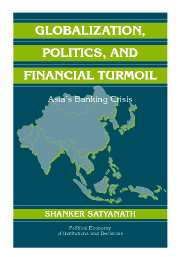Book contents
- Frontmatter
- Contents
- Figures and Tables
- Preface
- GLOBALIZATION, POLITICS, AND FINANCIAL TURMOIL
- 1 Introduction
- 2 Bank Regulation in the Debate over Capital Flow Liberalization
- 3 The Signaling Argument
- 4 Incredible Signaling in Democracies: The Cases of Thailand, South Korea, and the Philippines
- 5 Unorthodox Solutions to the Signaling Problem: The Cases of Malaysia and Indonesia
- 6 Orthodox Solutions to the Signaling Problem: The Cases of Singapore and Hong Kong
- 7 Some Concluding Remarks
- Appendix I The World Bank's Evaluation of Bank Regulatory Environments
- Appendix II Verbal Description of the Equilibrium with Two Signalers
- Appendix III Formal Proof of Equilibrium with Two Signalers
- Bibliography
- Interviews by the Author
- Index
- POLITICAL ECONOMY OF INSTITUTIONS AND DECISIONS
5 - Unorthodox Solutions to the Signaling Problem: The Cases of Malaysia and Indonesia
Published online by Cambridge University Press: 24 July 2009
- Frontmatter
- Contents
- Figures and Tables
- Preface
- GLOBALIZATION, POLITICS, AND FINANCIAL TURMOIL
- 1 Introduction
- 2 Bank Regulation in the Debate over Capital Flow Liberalization
- 3 The Signaling Argument
- 4 Incredible Signaling in Democracies: The Cases of Thailand, South Korea, and the Philippines
- 5 Unorthodox Solutions to the Signaling Problem: The Cases of Malaysia and Indonesia
- 6 Orthodox Solutions to the Signaling Problem: The Cases of Singapore and Hong Kong
- 7 Some Concluding Remarks
- Appendix I The World Bank's Evaluation of Bank Regulatory Environments
- Appendix II Verbal Description of the Equilibrium with Two Signalers
- Appendix III Formal Proof of Equilibrium with Two Signalers
- Bibliography
- Interviews by the Author
- Index
- POLITICAL ECONOMY OF INSTITUTIONS AND DECISIONS
Summary
The prediction of this book is that authoritarian environments are unlikely to be subject to either signaling or gridlock problems. Thus, unlike environments with even a moderate number of checks, we should generally observe outcomes that are consistent with the preferences of the chief executive. In this chapter I address the two countries where the chief executives adopted unorthodox solutions to the signaling problem following capital flow liberalization. In one case, the chief executive appointed a long-time friend from his home village to closely monitor the central bank and finance ministry from a special senior advisory position. In the other, the chief executive sidelined senior financial bureaucrats and instead relied on relatives and close cronies who owned banks as his primary source of information on the banking sector. In neither case is there evidence of signaling problems. The chief executives of both countries had close ties to the banking sector. The outcome, lax regulation, was in line with both chief executives' preferences.
MALAYSIA
In the years leading up to the Asian crisis, Malaysia was an authoritarian country where political power was largely concentrated in its prime minister, Mahathir Mohamad. In Section 5.1.1, I provide some background information on Malaysia's political and economic environment in the years leading up to the liberalization of capital inflows in 1990. In Section 5.1.2, I describe Prime Minister Mahathir's inner circle of banking advisors in the 1990s. In Section 5.1.3, I address the bank regulatory environment during this period.
- Type
- Chapter
- Information
- Globalization, Politics, and Financial TurmoilAsia's Banking Crisis, pp. 92 - 112Publisher: Cambridge University PressPrint publication year: 2005



